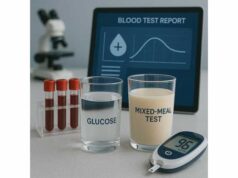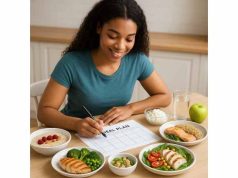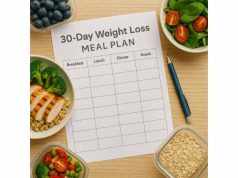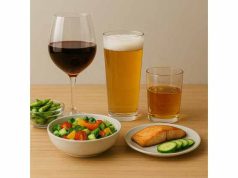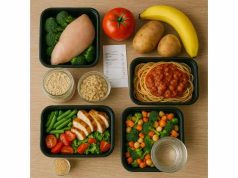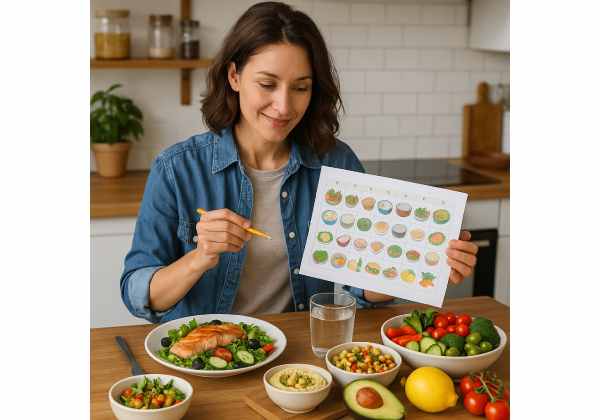
The Mediterranean way of eating is famous for long-term health, but it also works beautifully for weight loss when you plate it with intent. Think vegetables at every meal, generous but measured olive oil, plenty of fish and beans, and whole grains that keep you full. The result is a pattern that is flavorful, flexible, and easy to repeat—exactly what you need to stay in a calorie deficit without feeling deprived. If you want a quick refresher on setting calorie targets and planning your week, skim our guide to calorie goals and meal planning, then use the menu below to put the plan into action.
Table of Contents
- Mediterranean diet for weight loss
- How to follow it for fat loss
- 7-day sample menu 1500–1800 calories
- Shopping list and prep
- Common mistakes and fixes
- Safety and who should avoid
- Evidence and results to expect
- Frequently Asked Questions
Mediterranean diet for weight loss
“ Mediterranean diet” describes a pattern seen across coastal regions of Southern Europe and surrounding countries: meals built from vegetables, legumes, whole grains, fruit, nuts, seeds, olive oil, seafood, and modest amounts of dairy and lean meats. It is as much about how you eat—cooking at home, simple preparations, shared meals—as it is about what you eat.
Why it helps with fat loss:
- High satiety per calorie. Most meals center on vegetables, beans, or whole grains alongside lean proteins and healthy fats. You get volume, fiber, protein, and flavor that slow digestion and steady appetite.
- Protein distributed across the day. Fish, yogurt, eggs, legumes, and poultry make it easy to hit 25–40 grams of protein per meal without monotony.
- Healthy fats that satisfy. Olive oil and nuts deliver richness so smaller portions feel complete. Measured correctly, they support adherence rather than fighting your deficit.
- Few ultra-processed triggers. Building from whole ingredients reduces “bliss point” snacks that encourage grazing.
This is not a rigid rulebook. It is a template you can adapt to your schedule, budget, and preferences. A weight-loss version uses the plate method to keep portions honest: half vegetables, a quarter protein, a quarter slow-digesting carbohydrates, plus a measured thumb of fat (usually olive oil or nuts). It swaps heavy desserts for fruit most days and treats wine as optional and modest.
What about calories? Weight change is governed by energy balance. The Mediterranean pattern makes a deficit easier because it improves fullness and diet quality, but portions still determine your total intake. If you want a grounding in safe pacing and behavior change before you start, review our overview of safe weight-loss basics and then come back to build your plate.
Practical strengths:
- Flexible for families. Swap proteins and vegetables without changing the structure of the meal.
- Travel-friendly. Most restaurants have a grilled fish or chicken dish with vegetables and potatoes or rice you can portion by sight.
- Budget adaptable. Beans, lentils, frozen vegetables, canned tomatoes, and tinned fish make Mediterranean meals affordable.
Over the next sections, you will learn how to translate these ideas into daily portions, a complete 7-day menu (with vegetarian swaps), a one-hour prep plan, and a troubleshooting checklist to keep progress steady.
How to follow it for fat loss
You do not need to count every gram to lose weight on a Mediterranean pattern. You do need clear defaults and measured rich ingredients. Use the steps below to turn principles into repeatable habits.
1) Use the plate method at every main meal
- Half plate: vegetables (raw, roasted, sautéed, or soup). Aim for two colors.
- Quarter: protein (fish, chicken, turkey, eggs, Greek yogurt, beans or lentils).
- Quarter: high-fiber carbs (whole-wheat pasta, brown rice, farro, barley, potatoes).
- Fat: 1–2 teaspoons olive oil for cooking or 1–2 tablespoons vinaigrette. Add 1 tablespoon nuts or seeds if you prefer crunch—then reduce oil to keep calories balanced.
2) Set realistic protein anchors
Target 1.6–2.2 g/kg of goal body weight per day (about 0.7–1.0 g/lb), split across meals. Mediterranean staples make this easy: Greek yogurt bowls at breakfast; fish, chicken, or beans at lunch and dinner; edamame or skyr for snacks. If you are unsure how to size your deficit without extra hunger, see our guide to reduce hunger while you cut calories.
3) Choose carbs that pull their weight
Prefer whole grains, beans, lentils, potatoes, and fruit. These foods bring fiber, minerals, and slow-release energy. Keep portions to one cupped hand per meal (women) or two cupped hands (men), adjusting around training.
4) Measure rich ingredients for two weeks
Free-pouring olive oil and “handfuls” of nuts can quietly add 200–400 calories. For your first 14 days, measure oils by teaspoon at the stove and weigh nuts once to learn your typical overpour. After that, you can eyeball accurately.
5) Plan dessert and alcohol on purpose
Fruit is your default sweet note. If you enjoy wine, cap most days at one small glass and budget it like any other calorie source. Consider alcohol-free weekdays while cutting.
6) Distribute protein and fiber early
Protein at breakfast (eggs, yogurt, or skyr) and a vegetable-heavy lunch reduce evening cravings, which is where many people overshoot portions.
7) Keep fast “assemblies” on standby
- Greek salad with tuna and a whole-grain roll.
- Lentil soup with olive oil drizzle and side salad.
- Whole-wheat pasta tossed with chickpeas, tomatoes, spinach, garlic, and a tablespoon of Parmesan.
These are five-minute meals that maintain your structure when life is busy.
8) Track your trend, not just days
Weigh two to four times weekly and average the readings. If your 14-day trend stalls, cut one thumb of fat from two meals or trim half a cupped hand of starch at dinner while keeping vegetables and protein steady.
7-day sample menu 1500–1800 calories
This menu delivers balanced Mediterranean meals with 25–40 grams of protein at main meals and generous vegetables. The 1500–1800 calorie range suits many adults pursuing slow, sustainable loss; scale portions up or down using the hand cues in Section 2 and the notes under each day. Vegetarian swaps follow each dinner.
Day 1 (front-load color)
- Breakfast: Greek yogurt (1 cup) with berries, 2 tbsp muesli, cinnamon, and 1 tsp chopped walnuts.
- Lunch: Sardine and white bean salad (1 tin sardines, ½ cup cannellini beans, tomatoes, cucumber, arugula) with lemon-olive oil dressing; whole-grain roll (small).
- Snack: Apple and 15 almonds.
- Dinner: Lemon-herb chicken (150–180 g) with roasted broccoli and small baked potato; side salad with vinaigrette.
- Vegetarian swap: Chickpea “cutlets” or grilled halloumi (measured) in place of chicken.
Day 2 (soup and seafood)
- Breakfast: Vegetable omelet (2–3 eggs) with peppers, onions, spinach; one slice whole-grain toast; tomato.
- Lunch: Minestrone with extra beans, grated Parmesan (1 tsp), and side salad.
- Snack: Skyr (170 g) with sliced orange.
- Dinner: Baked salmon (150–170 g) with asparagus and ½ cup farro; lemon wedge.
- Vegetarian swap: Baked tofu or tempeh with the same sides.
Day 3 (beans done right)
- Breakfast: Overnight oats made with milk or fortified plant milk, chia (1 tsp), and berries; add 15 g pistachios.
- Lunch: Mediterranean tuna bowl: tuna pouch, cherry tomatoes, olives (5–6), cucumber, ½ cup quinoa, herbs.
- Snack: Carrots and 3 tbsp hummus.
- Dinner: Turkey meatballs in tomato-pepper sauce over whole-wheat spaghetti (¾ cup cooked) and a mountain of zucchini ribbons.
- Vegetarian swap: Lentil “meatballs” or white beans in the same sauce.
Day 4 (leftovers smart)
- Breakfast: Whole-grain toast with ricotta (or skyr) and strawberries; drizzle honey (½ tsp) if desired.
- Lunch: Leftover salmon flaked over Greek village salad (tomatoes, cucumber, feta, olives, onion) with olive oil and oregano; small pita or extra potatoes if hungry.
- Snack: Pear and 10–12 walnut halves (measure).
- Dinner: Sheet-pan chicken thighs (lean, skin removed after cooking) with peppers, onions, and roasted sweet potato wedges.
- Vegetarian swap: Roasted chickpeas and cauliflower steaks with the same spices.
Day 5 (pasta the Mediterranean way)
- Breakfast: Yogurt bowl with banana slices, cocoa dusting, and sunflower seeds (1 tsp).
- Lunch: Lentil salad with roasted carrots, herbs, lemon, and olive oil; side of greens.
- Snack: Edamame (¾ cup shelled) with sea salt.
- Dinner: Whole-wheat pasta (¾–1 cup cooked) tossed with shrimp, cherry tomatoes, garlic, spinach, and a tablespoon of grated Pecorino; large side salad.
- Vegetarian swap: Cannellini beans instead of shrimp.
Day 6 (market day)
- Breakfast: Shakshuka (2 eggs poached in tomato-pepper sauce) with small whole-grain roll or extra vegetables if you prefer lower starch.
- Lunch: Grilled chicken gyros bowl: chicken breast, cucumber, tomato, onion, olives, herbs, and a dollop of yogurt sauce; ½ cup brown rice.
- Snack: Berries with 1 tbsp slivered almonds.
- Dinner: Grilled white fish (cod or haddock) with ratatouille and ½ cup couscous or potatoes.
- Vegetarian swap: Grilled halloumi or marinated tofu with the same vegetables.
Day 7 (Sunday roast, Mediterranean style)
- Breakfast: Oatmeal cooked with milk, topped with diced apple, raisins (1 tbsp), and cinnamon; side of skyr if you need extra protein.
- Lunch: Tomato-basil soup and a tuna-and-white-bean open-face sandwich on whole-grain bread; arugula salad.
- Snack: Dark chocolate (10–15 g) and an orange.
- Dinner: Herb-roasted chicken (150–180 g) with lemony potatoes and green beans almondine; simple lettuce salad.
- Vegetarian swap: Portobello “steaks” with the same sides and a ½ cup extra beans for protein.
How to scale
- Need more energy? Add a half cupped hand of grains or potatoes at lunch and dinner, or a second tablespoon of olive oil across the day.
- Need fewer calories? Trim oils by one teaspoon at two meals and keep pasta or grains to ¾ cup cooked.
- High-training days: Add a pre- or post-workout snack of yogurt plus fruit or a small turkey sandwich on whole-grain bread.
For another way to structure a week by protein first, see our concise weekly template and layer Mediterranean ingredients on top.
Shopping list and prep
A one-hour session each weekend sets you up for effortless Mediterranean meals all week.
Smart shopping list
- Vegetables: leafy greens, tomatoes, cucumbers, peppers, zucchini, eggplant, onions, carrots, broccoli, cauliflower, spinach.
- Fruit: berries, apples, oranges, grapes, bananas, lemons.
- Proteins: salmon, white fish, shrimp, chicken breast/thighs, turkey mince, canned tuna or sardines, eggs, Greek yogurt, feta; plant options: chickpeas, lentils, cannellini, tofu/tempeh.
- Grains and starches: whole-wheat pasta, brown rice, quinoa, farro, barley, potatoes, sweet potatoes, whole-grain bread or small pitas.
- Fats and flavor: extra-virgin olive oil, olives, nuts (almonds, walnuts, pistachios), seeds, red wine vinegar, balsamic, capers, dried oregano, paprika, cumin, garlic.
- Convenience: low-sodium canned tomatoes, tomato paste, broth, frozen vegetables, pre-washed salad mixes.
One-hour prep plan
- Roast vegetables (20–25 minutes): Two trays—one with broccoli and carrots, one with peppers, zucchini, and onions. Drizzle 2 teaspoons olive oil per tray, salt, pepper, oregano.
- Cook a grain (20 minutes): Make a pot of quinoa or farro (3–4 cups cooked).
- Batch a protein (20 minutes): Grill or pan-sear 1 kg chicken breast with lemon, garlic, and paprika.
- Make a soup or sauce (15 minutes): Quick tomato-pepper sauce for shakshuka or meatballs; or minestrone base.
- Mix two dressings (5 minutes): Red wine vinaigrette and yogurt-herb sauce.
- Portion snacks (5 minutes): Nuts into 15–20 g bags; cut vegetables for hummus.
Storage tips
- Keep cooked grains and proteins in shallow containers (3–4 days in the fridge). Freeze a few single portions for “emergency dinners.”
- Store dressings in jars; shake before using.
- Assemble lunch bowls the night before: greens + roasted vegetables + protein + ½ cup grain + dressing in a separate container.
If you want a detailed timeline you can copy, use our streamlined one-hour prep and swap in Mediterranean ingredients.
Common mistakes and fixes
Even a great pattern can stall if portions drift. These are the pitfalls that most often slow fat loss on a Mediterranean plan—and the fast fixes.
Free-pouring olive oil
Olive oil is healthy and calorie-dense. A loose “glug” can add 120–200 calories.
Fix: Measure oils for two weeks. Use teaspoons at the stove and toss salads with 1–2 tablespoons vinaigrette for a whole bowl.
Calling all cheese “Mediterranean”
Cheese adds flavor, but large daily portions crowd out vegetables and lean protein.
Fix: Use small accents (1 tablespoon grated, matchbox-size feta) and keep the star of the plate vegetables, fish, or beans.
Bread without balance
A basket of bread before your entrée is easy to overeat.
Fix: Ask for bread with the main course; portion one small slice and pair it with your protein and salad.
Bean dishes without protein anchors
Legume stews can be light on protein per serving if mostly broth and vegetables.
Fix: Add extra beans or a protein topper (shrimp, chicken) to hit 25–40 g.
Restaurant pasta portions
Typical servings are 2–3 cups cooked.
Fix: Order a half portion or share. Keep pasta to ¾–1 cup cooked, load the dish with vegetables, and add protein.
Weekend wine creep
A couple of extra glasses on Friday and Saturday can erase the week’s deficit.
Fix: Choose alcohol-free weekdays or cap weekends at one small glass per day. Alternate with sparkling water and citrus.
For a broader checklist across your diet, see our guide to fix common diet mistakes and choose one lever to adjust this week.
Safety and who should avoid
The Mediterranean pattern is one of the most studied, with consistent links to heart and metabolic health. Still, context matters.
- Diabetes or glucose concerns: Carbohydrates are not off-limits. Emphasize beans, lentils, whole grains, and fruit; keep portions measured, and pair carbs with protein and olive oil to steady blood sugar.
- Kidney disease: Protein and sodium targets are individualized. Work with your clinician to set limits.
- Celiac disease or gluten sensitivity: Choose naturally gluten-free grains (brown rice, quinoa, buckwheat) and potatoes.
- Lactose intolerance: Use lactose-free milk, aged cheeses in small amounts, or rely on plant proteins and fish instead.
- Alcohol: Wine is optional, not required. If you have a history of misuse, skip it entirely.
- Digestive issues: High-fiber changes can bloat at first. Increase beans and whole grains gradually and drink enough fluids. Practical ideas live in our overview of hydration strategies.
Pregnant or breastfeeding? Weight loss is not usually the goal. Use the Mediterranean pattern for nourishment, not restriction, and discuss energy needs with your care team.
Evidence and results to expect
When people switch to a Mediterranean pattern and keep portions reasonable, three things usually happen:
- Diet quality rises. More vegetables, beans, and seafood mean more fiber, potassium, magnesium, and omega-3s—nutrients that support satiety and heart health.
- Hunger becomes easier to manage. Meals with protein, fiber, and olive oil create steady energy and reduce snack impulses.
- Weight trends down. Many see a modest loss in the first month as water balances and portions normalize, then a steady rate of 0.25–0.75 kg (½–1½ lb) per week depending on deficit and activity.
What success looks like:
- You can repeat most meals without boredom.
- Your grocery list is short, with a few rotating proteins and grains.
- You hit protein at each meal and eat vegetables without thinking.
- On restaurant nights, you order a grilled protein, double vegetables, and a measured starch—and enjoy it.
Treat the next two weeks as a trial. Run the 7-day menu twice, adjust portions using the hand cues, and watch your 14-day average weight. If the trend stalls, trim cooking oils slightly or tighten restaurant portions before cutting entire food groups.
Frequently Asked Questions
Is the Mediterranean diet good for weight loss?
Yes. It emphasizes vegetables, beans, whole grains, seafood, and olive oil in portions that produce high fullness per calorie. When you use the plate method and measure rich ingredients, it helps you maintain a calorie deficit without feeling restricted.
Do I have to drink wine to follow this diet?
No. Wine is optional. If you choose to drink, keep portions modest and plan it like any other calorie source. Alcohol-free weekdays are a simple way to protect your deficit while keeping the Mediterranean pattern intact.
How much pasta or rice can I eat and still lose weight?
Keep cooked pasta or grains to ¾–1 cup per meal, load the plate with vegetables, and include a protein anchor. Around workouts you can add a half cupped hand more. Whole grains and beans offer better satiety than refined options.
Can I follow this diet if I am vegetarian?
Absolutely. Base meals on beans, lentils, tofu, whole grains, vegetables, fruit, nuts, and olive oil. Aim for 25–40 g of protein at meals by combining legumes with higher-protein foods like Greek yogurt, skyr, or tofu depending on your preferences.
What if I am still hungry after meals?
Check your plate: do you have half vegetables, 25–40 g protein, and a measured fat? Add a fist of vegetables or ½ cup beans, sip water, and give yourself ten minutes. If hunger persists, raise per-meal protein by 5–10 g.
How fast should I expect to lose weight?
A steady rate is 0.25–0.75 kg per week for most people. Monitor your 14-day weight average and adjust oils or starch portions slightly if the trend stalls. Sleep, steps, and stress also influence progress; focus on consistency over quick drops.
References
- An Energy-Reduced Mediterranean Diet, Physical Activity, and Body Composition: An Interim Subgroup Analysis of the PREDIMED-Plus Randomized Clinical Trial 2023 (RCT)
- Effect of a Lifestyle Intervention Program With Energy-Restricted Mediterranean Diet and Exercise on Weight Loss and Cardiovascular Risk Factors: One-Year Results of the PREDIMED-Plus Trial 2019 (RCT)
- The effects of Mediterranean diet on cardiovascular risk factors, glycemic control and weight loss in patients with type 2 diabetes: a meta-analysis 2024 (Systematic Review)
- Comparison of dietary macronutrient patterns of 14 popular named dietary programmes for weight and cardiovascular risk factor reduction in adults: systematic review and network meta-analysis of randomised trials 2020 (Systematic Review/Network Meta-analysis)
- Systematic review and meta‐analysis of protein intake to support muscle mass and function in healthy adults 2022 (Systematic Review)
Disclaimer
This article provides general nutrition guidance and a sample menu for adults. It is not a substitute for personalized medical advice, diagnosis, or treatment. If you have a medical condition, take prescription medications, are pregnant, or are breastfeeding, consult your healthcare professional before changing your diet.
Share and follow
If this menu helped you plan the week, consider sharing it with a friend who is refreshing their meals. For steady, research-based tips, follow us on the social network you use most.

